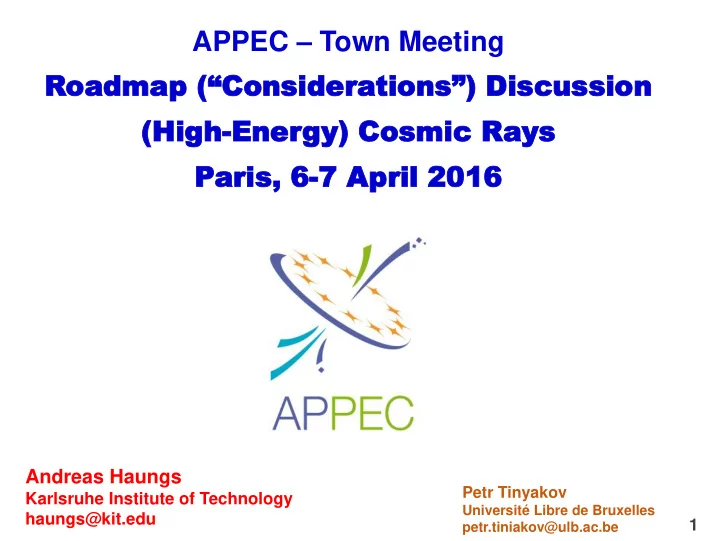

APPEC – Town Meeting Roadmap (“Considerations”) Discussion (High (High-Ene Energy) y) Co Cosmic Ra smic Rays ys Paris, aris, 6-7 7 April pril 201 2016 Andreas Haungs Petr Tinyakov Karlsruhe Institute of Technology Université Libre de Bruxelles haungs@kit.edu 1 petr.tiniakov@ulb.ac.be
Energy spectrum 2
Energy spectrum transition galactic- extragalactic Low energy EAS measurements (high-altitude) highest energy cosmic rays 3
Questions / Challenges of the experiments Spectral indices? Antimatter? Composition / Isotopes? Overlap direct-indirect measurements? Hadronic interaction models? Fine-structures in spectrum? End of Galactic Spectrum? Composition? GZK / maximum acceleration? Anisotropy? … and many more! 4 Engel, Blümer, Hörandel: Progress in Particle and Nuclear Physics 63 (2009) 293
Measurement Techniques of Air Showers 5
Pierre Auger Observatory 6
Pierre Auger Observatory: Results one decade ago: ➙ not known whether flux suppression exists ➙ composition expected to be protons ➙ no anisotropies observed ~450 collaborators; 92 institutions, 17 countries today: ➙ flux suppression (50 EeV) beyond any doubt ➙ anisotropies (large scale) seen ➙ evidence to become heavier ➙ cosmogenic g and n are constrained ➙ particle physics performed s (pp) @ 57TeV cms ➙ atmospheric effects, LIV studies , …. ➙ …. but, flux suppression mechanism unclear but, no sources of UHECR identified - yet 7
Auger-upgrade (AugerPrime) Science Goals 1. Elucidate the origin of the flux suppression, i.e. GZK vs. maximum energy scenario ➙ fundamental constraints on UHECR sources ➙ galactic vs extragalactic origin ➙ reliable predictions of GZK n - and g -fluxes 2. Search for a flux contribution of protons up to the highest energies at a level of ~ 10% ➙ proton astronomy up to highest energies ➙ prospects of future UHECR experiments 3. Study of extensive air showers and hadronic multi-particle production above √s=70 TeV ➙ particle physics beyond man-made accelerators ➙ derivation of constraints on new physics phenomena Pierre Auger Observatory is in place to address all these questions now 8
Auger upgrade (AugerPrime) Status: • positively evaluated by International Advisory Committee • endorsed by International Finance Board • R&D well advanced, prototypes running • 11/2015: International Agreement • signed for operation into 2025 • engineering array 08/2016 • construction 01/2017 - 2018 • data taking into 2025 • costs: 12.5 M € • funding: ~50% already committed 194 pages 9
Telescope Array 10
Telescope Array TAx4: • SD: 700 ➔ 2800 km 2 • Hybrid: x3 acceptance • Optimized for above ~50 EeV Goal: Get 20 TA-years by 2019 to look for structure within hotspot! 3.7 M$US approved by Japan for 500 SD funding fro FD is seeked fo in the US minor European contribution 11
GCOS = Global COSmic ray observatory Helmholtz (D) large infrastructure Roadmap p-astronomy with sources • Global, few sites, N+S • Design in 2020-25 • ca. 90,000 km 2 (x30 Auger) • Operation 2025-2050 • Optimal detector for • Cost 390 M € (120 M € European contr.) • Operation cost 6 M € /y composition-sensitivity 12
JEM-EUSO 13
Air Shower Observations from Space X-EUSO-X 2023 2014 2020 2017 Launch 2017 Announcement of Opportunity ? cancelled from NASA in 2016 for ISS 2021-24? Mini-EUSO on ISS M5 mission TA-EUSO EUSO-Balloon (approved for 2018) Free flyer? 1 st flight 2014 Continuous operation Baseline design change to SiPM-PDM? EUSO-SPB Proposal 201? Preparation in work (including small SiPM-camera) Launch spring 2017 Russian line K-EUSO TUS 358 authors; 95 institutions; 16 countries
Further experiments with possible strategic relevance • LHAASO CR around knee with multi-detector installation China - with participation of France, Italy • TAIGA/ Tunka/HiSCORE/Tunka -Taiga-Rex CR around knee and up to ankle with multi-detector installation Russia - with participation of Germany, more? • IceCube/IceT op – (Gen2) Ice-Cherenkov array on top of IceCube USA – with important European contribution Advanced plans for Gen2-surface (veto) array • GRAPES KASCADE-like operating array at 2300m altitude India - with participation from Japan • KCDC KASCADE Cosmic ray Data Centre for public use Extension to other experiments foreseen (Auger?) 15
LHAASO 16
Tunka / Tunka-Rex / HiScore 17
IceCube / IceTop (-Gen2) 18
GRAPES 19
https://kcdc.ikp.kit.edu 20
AMS 21
SWOT: AugerPrime Strength Weakness Opportunities Threats • too low • environmental • small statistics • European statistics infrastructure at high leadership exist energies • uncertainty due • definition of • clear science to models science task questions for GCOS • part of multi- • R&D for next messenger program generation experiment • cost efficient • collaboration (funding agencies) exist • working groups with TA 22 exist
SWOT: all CR Strength Weakness Opportunities Threats • global • mostly • excluded from • cost effective programm for non-European R&D European all energies dominated contribution • missing visible • ready for multi- • small visibility • participation in European messenger hardware R&D participation • complementary • ready / preparing with LHC public data dissemination • close community (for air-shower observations) 23
APPEC Roadmap for high-energy cosmic-rays Pierre Auger Observatory is key experiment Full support of Upgrade Strategy (AugerPrime) ➙ cost estimation is rational ➙ R&D for GCOS JEM-EUSO like detector: situation unclear, test experiments running! Support of further design and R&D studies ➙ if, than funding by space agencies (?) Other experiments with small European contribution Mentioning and support of continuation of R&D ➙ institutional and national funding (?) Low energy (space/balloon) cosmic ray investigation? ➙ AMS analysis / ISS-CREAM? Funding by space agencies? Data dissemination (open access to scientific data) Need more room and efforts in next decade ➙ institutional and national funding only? 24
Recommend
More recommend